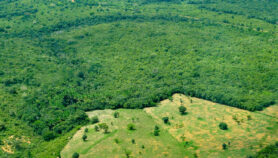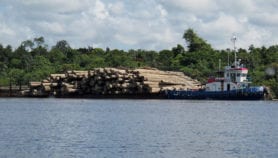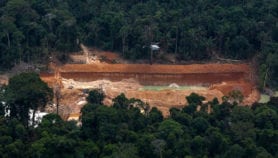Send to a friend
The details you provide on this page will not be used to send unsolicited email, and will not be sold to a 3rd party. See privacy policy.
Practicalities of trading carbon and protecting forests make meeting high expectations for REDD hard, say Esteve Corbera and Manuel Estrada.
It is clear that any effective international ‘deal’ on climate change must decrease emissions from deforestation and land-use change that represent about a fifth of all emissions. An international mechanism to fund such reductions, reducing emissions from deforestation and forest degradation (REDD), is emerging as a global blueprint to achieve this, and expectations are high.
Many developing countries are keen to participate because entering the regulated carbon market, which represented US$126 billion in 2008, raises hopes of long-term income.
Developed countries are similarly enthusiastic. REDD offers them a relatively cheap way to meet their commitments under the Kyoto Protocol (or any new climate change treaty) and could also encourage developing countries to sign up to voluntary emission reduction commitments at a sectoral level in the next round of climate negotiations.
But designing a framework that will live up to everyone’s expectations will be hard, given the divergent political, institutional, technical and governance capacities within the developing world.
Permanent commitment
One immediate problem is that current proposals are for payment after emissions have been reduced. So countries would have to design and implement carbon reduction policies with their own resources — an unlikely course for those already facing significant budgetary constraints and other more pressing issues, such as poverty, health and education.
Even if the carbon market could deliver up-front funding through innovative financial mechanisms, whether it can ensure deforestation is kept low in the long-term is debatable.
Put simply, the carbon stored in forests can only be counted as emitted to the atmosphere once — so avoiding these emissions can only be sold and used against emissions reduction targets once. Developing countries are essentially being asked to accept a one-off payment for the carbon in their forests, in exchange for permanently committing to avoiding land-use change.
Indeed, if a ‘seller’s liability’ approach is used to define the rules for REDD, this commitment could even become a financial obligation for developing countries — that is, they would have to pay up for any carbon loss for which credits have already been issued and sold.
Checks and balances
An even bigger problem for developing countries is certification. To enter the carbon market, REDD initiatives must generate real, measurable, long-term and additional emissions reductions that are certifiable by a third party. But few developing countries have the resources or expertise to collect enough data on land-use change or carbon storage to fulfill such criteria.
Sure, some individual projects have been successful — emissions reductions from the Noel Kempff Mercado National Park in Bolivia, for example, have been certified by the verification company SGS. But national emissions inventories in most developing countries do not meet the Kyoto Protocol’s clean development mechanism (CDM) standards. For example, Mexico’s reported emissions for the land-use sector over the period 1993-2002 had different degrees of uncertainty depending on the data collection methods and the reporting source, with uncertainty ranging between 4 and 34 per cent.
Equally problematic is ensuring that individual REDD credits in the carbon market are properly equivalent to each other (i.e. are fully fungible). Regulations to ensure this, set by buyer countries, could limit demand for credits and so reduce funding for REDD activities.
The European Emissions Trading Scheme’s exclusion of credits from afforestation and reforestation CDM projects is a good example of how a potentially large mitigation option can be effectively nullified by regulation in buyer countries (see Climate deals should reward wider forest management and Africa needs agroforestry to cut forest emissions). If REDD is to be successful, national regulations in buyer countries will have to meet rules agreed under the UNFCCC.
Essential groundwork
So it seems unlikely that large numbers of tradable REDD credits will be generated in the short term. Pilot activities, but also massive capacity building, will be needed within the next few years if countries are to pave the way for significant emissions reductions. For example, specific and detailed assessments of what drives deforestation at national and regional levels will be required to show where REDD is most needed, how deforestation and degradation should be tackled and who should be involved in conservation efforts.
Meanwhile, governments and research organisations should be building scientific and technical expertise so that REDD’s future architecture does not rely on developed countries’ consultants and private organisations, as has often been the case for CDM projects.
Even assuming that the funding issues and technical problems are solved, there are still significant management and governance hurdles to overcome. For example, forest management programmes often fail due to limited staff, equipment and training, corruption among government officers, and misunderstandings about existing property and benefit-sharing arrangements with rural communities.
Informal and customary tenure makes it difficult to set formal contracts with rural stakeholders, and particularly with the most disenfranchised. This means that as well as building scientific and technological capacity to measure, report and verify emission reduction projects, REDD must help improve governance and fairly reward indigenous peoples and communities.
Identifying all the stakeholders, raising awareness about REDD and consulting on how the scheme can or should work are crucial to a successful mechanism for reducing forest emissions. All of these require time and must not be rushed, simply to match the starting date of a post-2012 climate policy regime, or the agenda of supporting organisations.
Esteve Corbera is a researcher at the School of International Development, University of East Anglia, and the Tyndall Centre for Climate Change Research in the United Kingdom.
Manuel Estrada is an independent senior consultant on climate change, Mexico.













